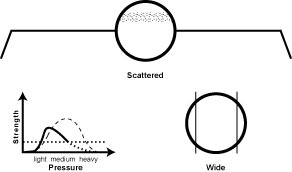The Scattered, Dissipated Pulse (San Mai)

Scattered Pulse (?? San Mai, dissipated)
Key points: superficial, scattered without root, uneven rhythm
Indications: exhaustion of qi, functional failure of the zang fu organs.
Explanation: anti-pathogenic qi is exhausted, dispersion of the yang qi due to dissociation of yin and yang causes the pulse to float to the surface.
This is a pulse that appears closer to the end of life than the beginning. This is probably the closest pulse we find to the so-called “true visceral pulses” which are pulses that indicate imminent separation of yin and yang. The true visceral pulses are not described in this article, but they do appear in our book as well as the Practical Diagnosis in Traditional Chinese Medicine
.

The Scattered Pulse

Comparison of Scattered, Faint, and Deficient Pulses
Next: at long last, it’s the long pulse.
 Last modified: July 24, 2009
Last modified: July 24, 2009  Tags: Diagnosis, Palpation · Posted in: Pulse Class, Pulse-Palpation
Tags: Diagnosis, Palpation · Posted in: Pulse Class, Pulse-Palpation
